Welcome to Part 3 of the School of Golf Architecture! For an introduction to this series, check out the first installment.
The latest SOGA podcast, featuring a discussion with Riley Johns about tie-ins, is below. Give it a listen, or continue reading, or go nuts and try both…
Opening thoughts
When I started building this series, I didn’t exactly have a plan. It’s like I’m playing with a set of old-school legos, just connecting one piece at a time and hoping I’ll end up with something cool.
But looking back, I realize that the first three installments have centered on a single theme: the relationship between a golf course and its site. First, we talked to Blake Conant about place; next, we spoke with George Waters about linksland; and today we turn our attention to the art of blending a course in with its surroundings. Specifically, we explore how architects and shapers create “tie-ins,” those features that mediate between manufactured and preexisting landforms.
On a completely natural golf course (if such a thing is possible), tie-ins would not be necessary. The holes would already be tied in, as they would be no different from the land itself. But the more that builders alter the terrain, the tougher it becomes to reunite the course with its setting.
These days, tie-ins are especially important in golf construction. Modern architects, even ones who respect the lay of the land, move a great deal of earth. At the same time, fashion has moved toward courses that fit in with their environments. Tie-ins make it possible for those two trends not to be at war with one another.
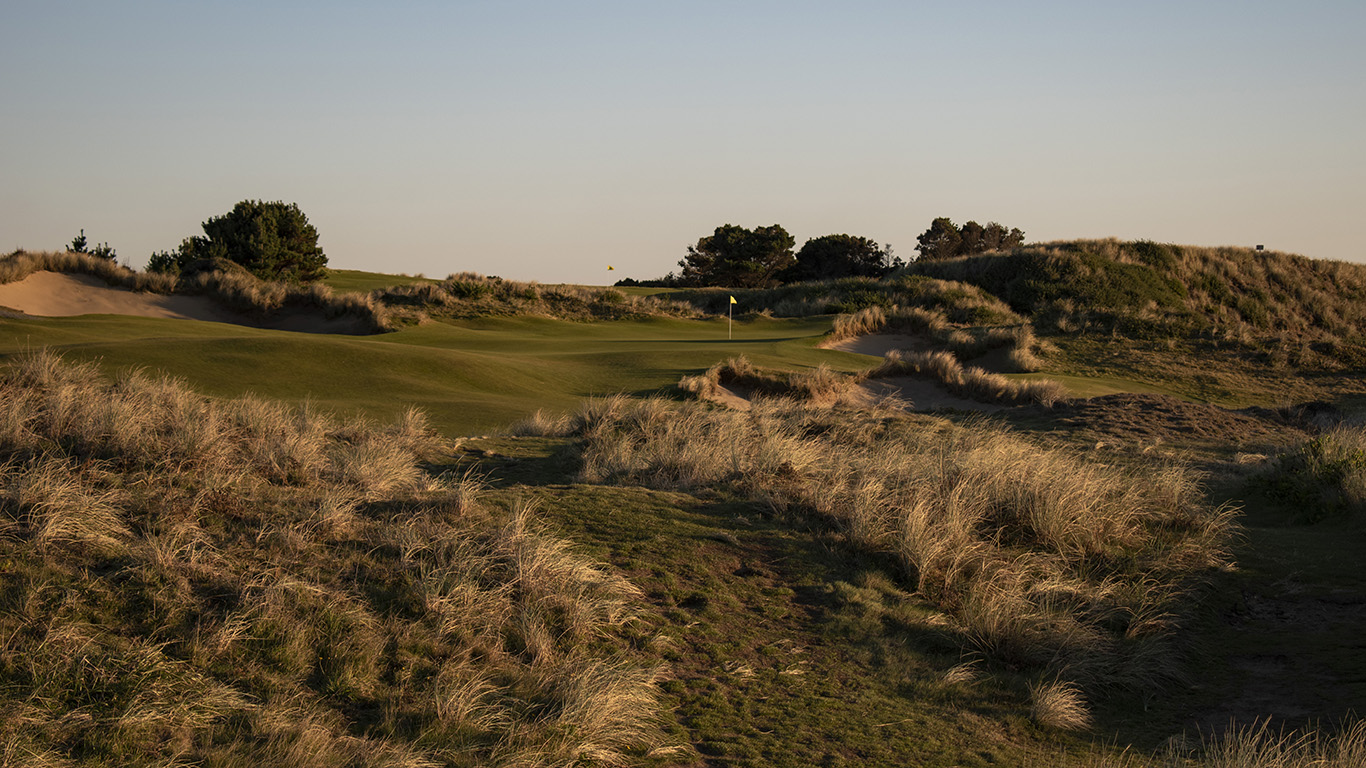
The 5th hole at Pacific Dunes. The bunker edges jut out but blend into the surrounding contours. Photo credit: Garrett Morrison
So if you spend much time with today’s golf course builders, you will likely hear them talk about “fitting” or “blending” or “tying in” their work with the landscape. To outsiders, it’s a somewhat mysterious subject. What exactly do tie-ins look like? How do you make them? What are they supposed to do? To learn more, I reached out to Riley Johns.
Riley has helped Coore & Crenshaw, Tom Doak, Jim Urbina, and Rod Whitman build some of the 21st century’s most harmonious golfing grounds. In 2013, he founded Integrative Golf Design, and in 2016, he and Keith Rhebb renovated the municipal Winter Park Nine in Florida. That course now meshes with its community in a mutually beneficial, mutually beautifying way. More recently, Riley and Keith designed a 10-hole short course at Forest Dunes and started a restoration of William Flynn’s Rolling Green.
Earlier this week, Riley snuck out to his office in downtown Canmore, Canada, to let me in on the secrets of the tie-in.
Highlights from the interview with Riley Johns
On the different kinds of tie-ins:
The obvious one would be a physical tie-in. And that would be connecting topographical elevations or grades, mimicking landforms. Grassing lines, you could tie those together.
But there are different kinds of tie-ins. You could have environmental and visual tie-ins. A visual would be the backdrop of a golf hole. Horizon lines are critical. We work really hard on making sure our horizon lines [on the golf course] don’t clash with the horizon lines of the backdrop. You want to accent views, focus views, or even obscure views. But it’s all about framing the picture. An environmental tie-in would be a bit more like vegetation—we would make sure that the color and texture and composition of the native landscapes integrate with the turf and the golf components. But typically the three go hand-in-hand. Physical, environmental, and visual: you’re tying those three things together all the time when you’re creating a golf hole.
You could have a cultural tie-in, a historical tie-in, a spiritual tie-in. A historical tie-in would be like at the Old Course at St. Andrews: the built environment, the town, the structures, the steeples and the buildings and the streets. As you approach the town on the way back in, you’re walking in the same footsteps that, historically, every great golfer has walked in.
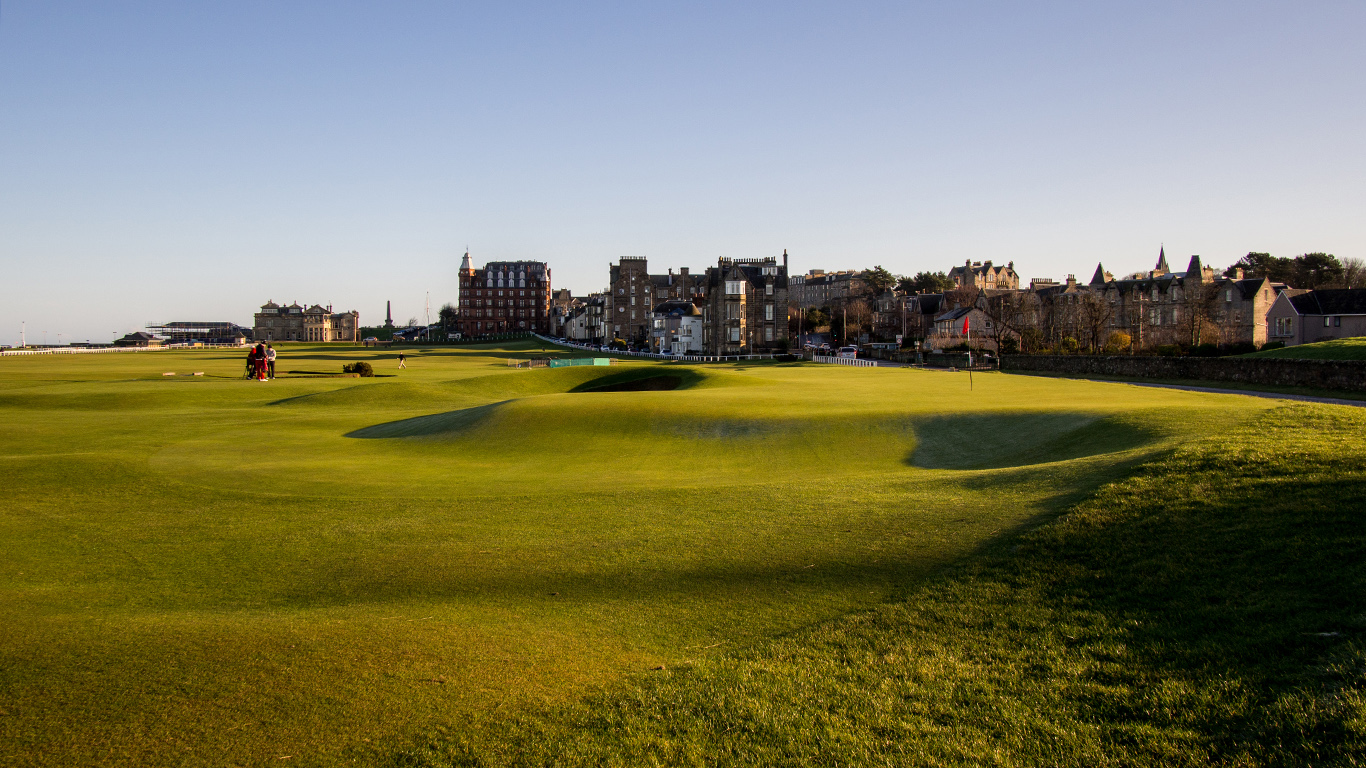
The Road Hole. Photo credit: Clyde Johnson
Cultural tie-ins are so nuanced. At Winter Park, what we did there was a cultural or community tie-in. The best way to describe how we did that was the elimination of any sort of barriers or fences, connecting the golf directly to the sidewalk or the street or whatever—a water fountain—and blending those two elements.
And golf’s a funny game, where you can also have a spiritual tie-in. We’ve all felt it, right? When we play a certain round with certain people at a certain time, whether it’s morning and the fog is lifting—it’s a very spiritual moment, and somehow the golf course has connected spiritually with that landscape.
On landscapes that are difficult to tie into golf courses:
Any course where the natural lay of the land is so stunning and so distinct and so beautiful—it’s hard to recreate that. Just due to the nature of construction, you end up destroying a lot of it. You try not to, but sometimes you need a haul road to access an area for materials or whatever the situation may be. Sometimes you have to massage shapes into the landscape to fit a green or tee or bunker. And so the idea is, after this destruction of the natural landscape, how do we reconstruct it? How do we put Humpty Dumpty back together again? That’s the hardest part. When you have already complex, rich textures and colors—a landscape that has evolved in that particular spot to its microclimate over hundreds of years—you can’t necessarily recreate that in a month.
On creating “FrankenDune” at Cabot Cliffs:
At Cabot Cliffs on No. 2, there was a big hillside that was covered in trees, and the process of removing and grubbing those trees essentially denuded that hillside. We had to figure out how to shape some tees in there, but then tie it back into the natural-looking dunescape. So we took the native sand, some marram grass, some logs, some wood, some brush, some different native vegetation—we call it “chunking,” where you take scoops of material from elsewhere on site and you plug it into places where you’ve worked. It will eventually grow in and spread and propagate itself. So what we had to do was essentially create a massive faux dune—we called it “FrankenDune.” We were waiting for a lightning strike and it was going to come alive. Then we let the wind hit it. We let the natural elements start to do their thing.
So that’s an extreme example of us playing off the natural surrounds and trying to bridge the gap between what we had to create and what was existing. And we had to choose what element that was going to be because you could do anything, right? You could replant trees, you could just seed it with some fescue grass. You could let it be and see what native plants reemerge. So you have to make those decisions. What’s your theme? What’s your inspiration? And then go for it and create it. You know, we’re faking nature.
-
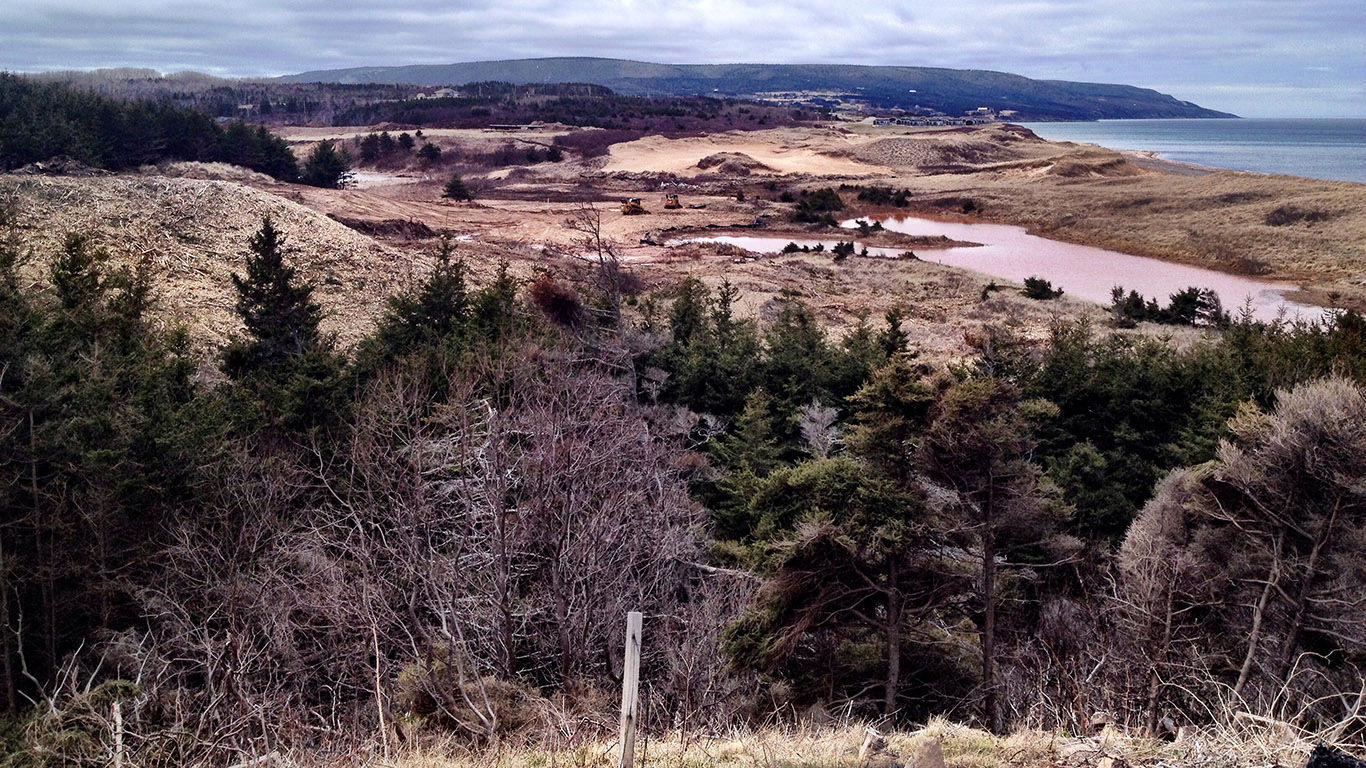
The denuded hillside on No. 2 at Cabot Cliffs. Photo credit: Riley Johns
-
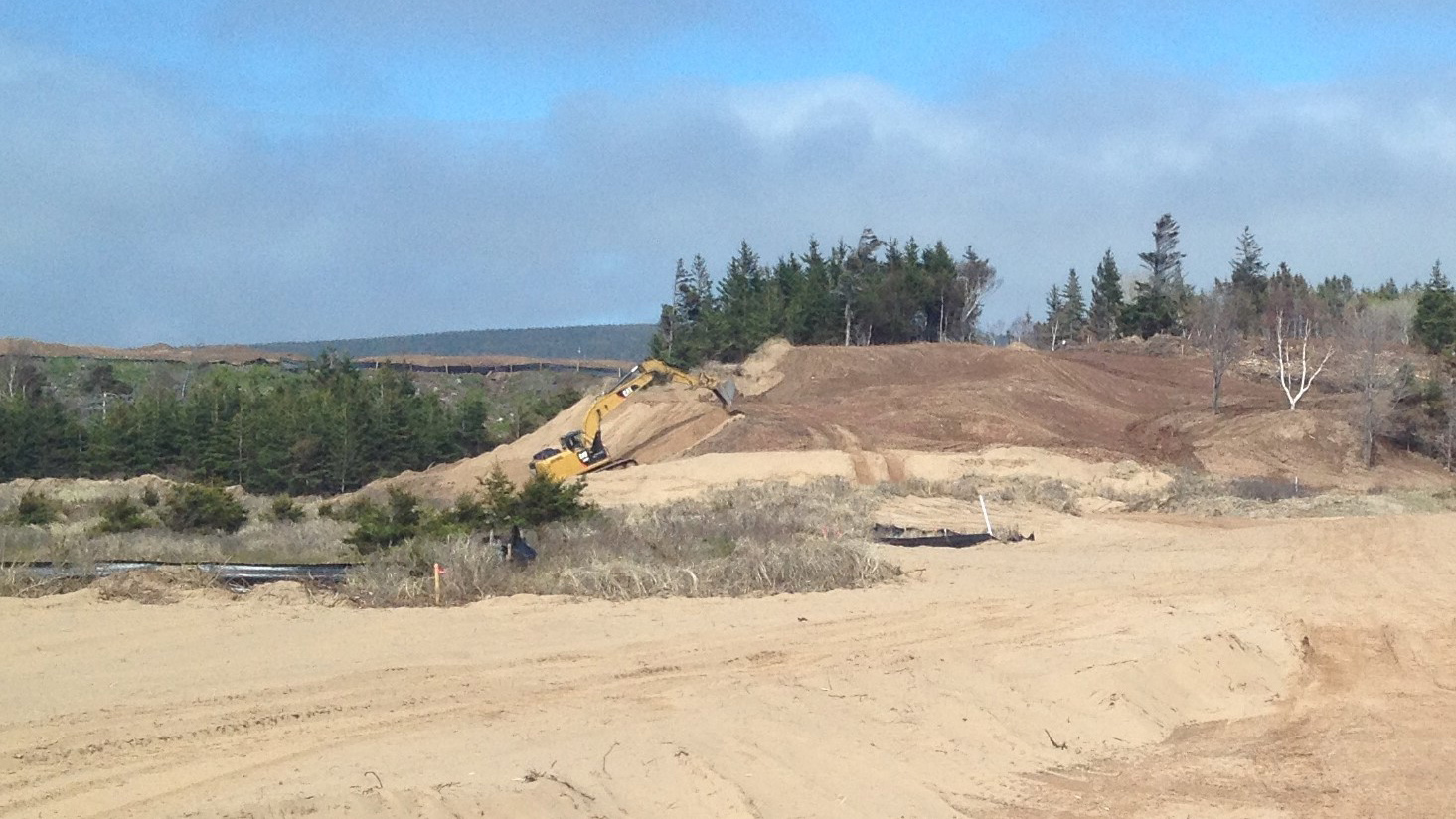
The FrankenDune in construction on No. 2 at Cabot Cliffs. Photo credit: Riley Johns
-
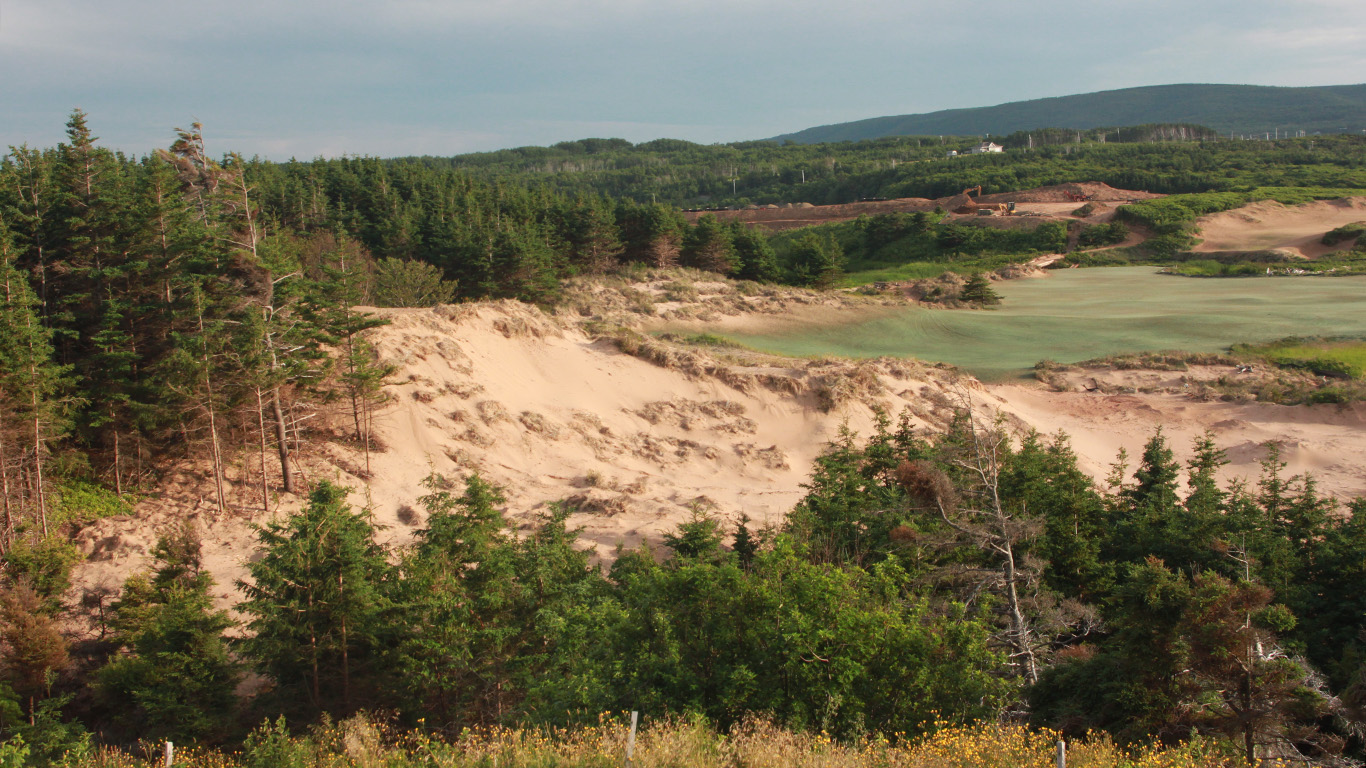
The finished FrankenDune. Photo credit: Riley Johns
On community tie-ins at Winter Park:
There was no bounty of colors and textures and landscape. It was human-built form. We had to tie in with city infrastructure, whether that be an electrical transformer box, a sidewalk, a street curb, the drip line of existing trees that were to remain historic trees. Typically you would love to string out your tie-in. The tighter of a box you’re placed in, the more difficult it is to tie in. At Winter Park, we were bound by the street corners. Our constraints were given to us. So our only tie-ins that we could do, other than tying in physically to the streetscape, were visual corridors, experiential tie-ins, community and culture and those things we discussed before. We wanted to open up different views to structures, whether the church or the cemetery or the streets or the sidewalks.
We also opened up views in the opposite direction. We’re always thinking, “Oh, what’s the golfer’s perspective?” But Winter Park was a weird animal because we were also cognizant of the other people’s perspective—the people commuting, driving by, the people walking their dog down the street, the people biking by. We wanted to give them the experience of the golf course without having to play it.
Before we got there, there was an entire cluster of trees hiding the train tracks. So we felt like rather than denying the train tracks, rather than concealing them, let’s embrace them and bring them into the golf course physically and visually. So we cleared all those trees, and we tied the golf course into the train tracks. If you stand on 6 tee today, and you see a train going by, it will appear as if the train is driving on top of the golf hole. Visually, we tried to connect the grade and the train tracks in a way that your perspective gave the illusion that the train was floating on top of the grass. We wanted to tie in the fact that, historically and culturally, this train system was instrumental in the creation and development and success of Winter Park as a community. So now people have a connection with the train tracks, with the golf course, with the community, and visually they all get bridged together. And audibly—you can hear the train whistle from different parts of the golf course.
All of these things create a sense of place, and give the golf course more of a distinct DNA. It’s more memorable, there’s more intrigue, there’s more layers of flavor to the golf experience.
-
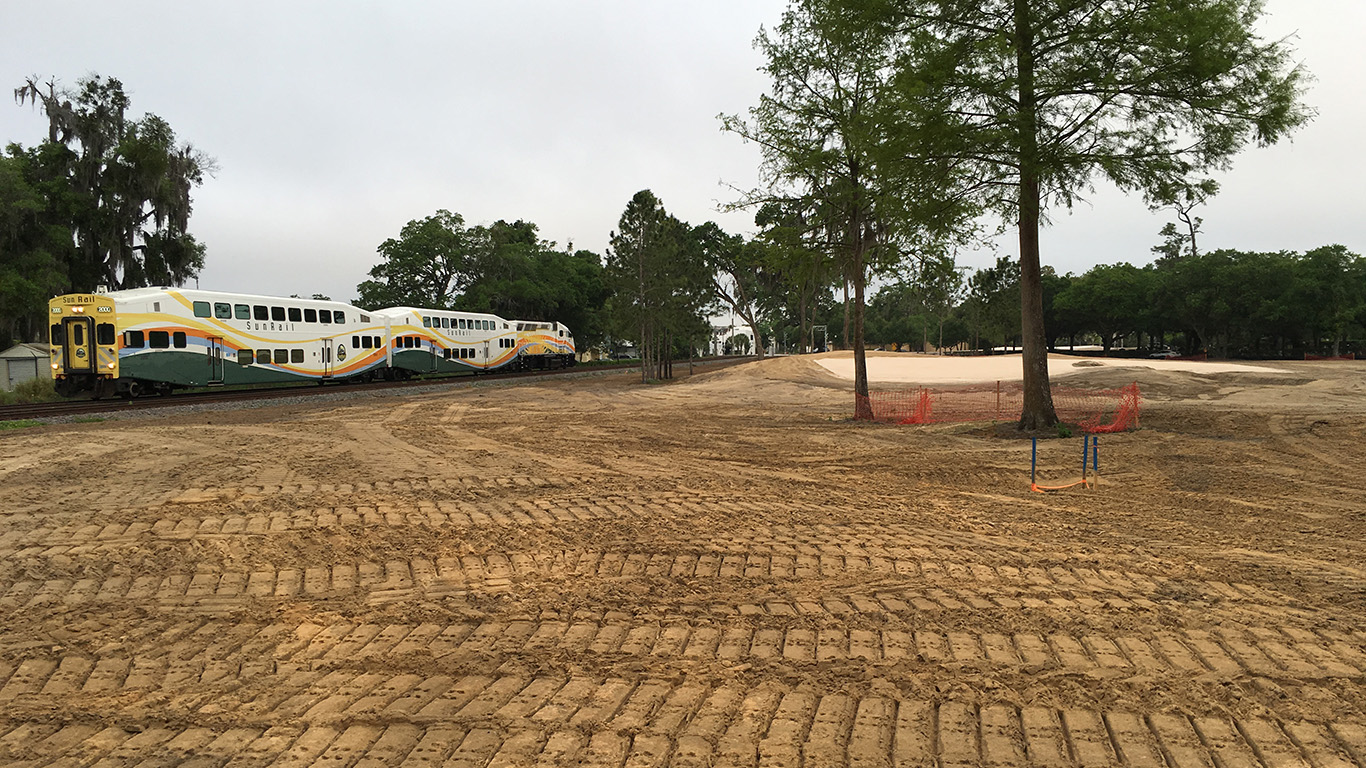
The train-track tie-in on No. 6 at Winter Park during construction. Photo credit: Riley Johns
-
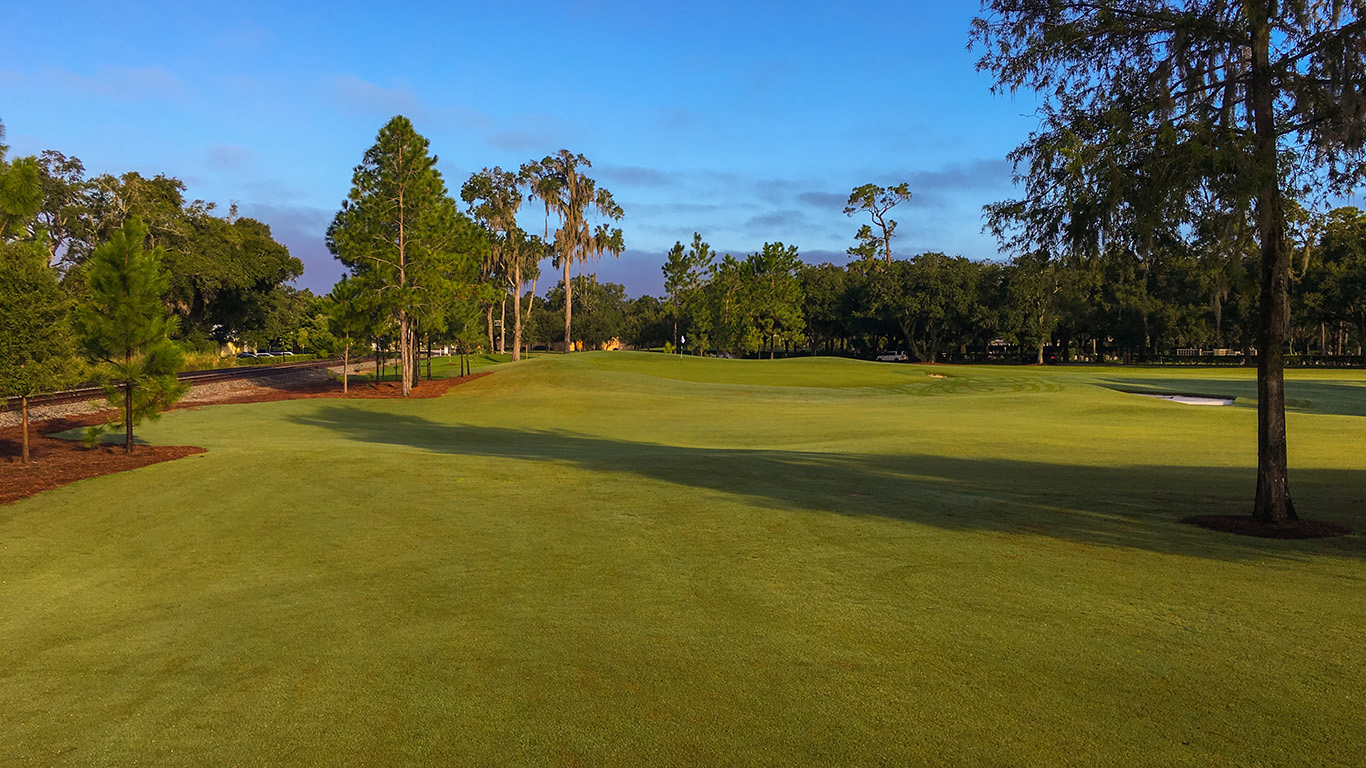
The train-track tie-in on No. 6 at Winter Park. Photo credit: Riley Johns
On how different courses draw on different techniques of tying in:
Whether you’re designing a house or a golf course or a car, everyone uses the same design elements to achieve whatever they want to achieve. Perspective, line, form, color, texture, repetition, emphasis, balance, variety, scale, symmetry—all of those things are design tools, elements that you can use when trying to conceal your work or tie in your work.
So a lot of the tie-ins that we’re talking about here, whether Pinehurst No. 2 or the heathland courses, a lot of that is form and color and texture.
But Royal Dornoch is another example. It ties in using gorse, and it gives a connecting thread throughout the entire property. Royal Melbourne and the Sandbelt courses in Australia, they tie in to their existing landforms in a way that’s distinct to the Sandbelt. Cypress Point ties in with the Monterey Peninsula, ties into the rocks, the ocean—the way that the form of the bunkers mimics the form of the Cypress trees. Sand Hills, Nebraska: they didn’t go with Kentucky bluegrass and get it all vibrant green. They went with fescue, and the fescues bleed into the fairway and bleed out of the fairway. The golf course looks found, the way that the sand scabs look like they were created by the wind. And those tie into the character and patterns of the entire Sandhills region.
All of these different elements go in as layers. You go into a golf course project first stripping layers away, and then you build the golf course, and then you start bringing the layers back, and you start melding them together.
On tricks and tie-ins:
How do we make that landscape believable? How do we make it look plausible that nature created this and we just mowed it out and put a pin there and called it done?
But then you add this element: a golf course is an art piece that’s meant to be played, experienced, and interacted with. So now you’ve got this other component. It’s deception. It’s planned confusion and illusion and warped perspective and visual emphasis and all these tricks of landscape design. Perhaps we’re subtly nudging a golfer in a certain direction or doing something to their state of mind subconsciously. Tying those [elements] into the landforms gives it believability.
And now you have this adventure on a planned landscape that looks like it was found. And there’s something about that that gives us immense pleasure.
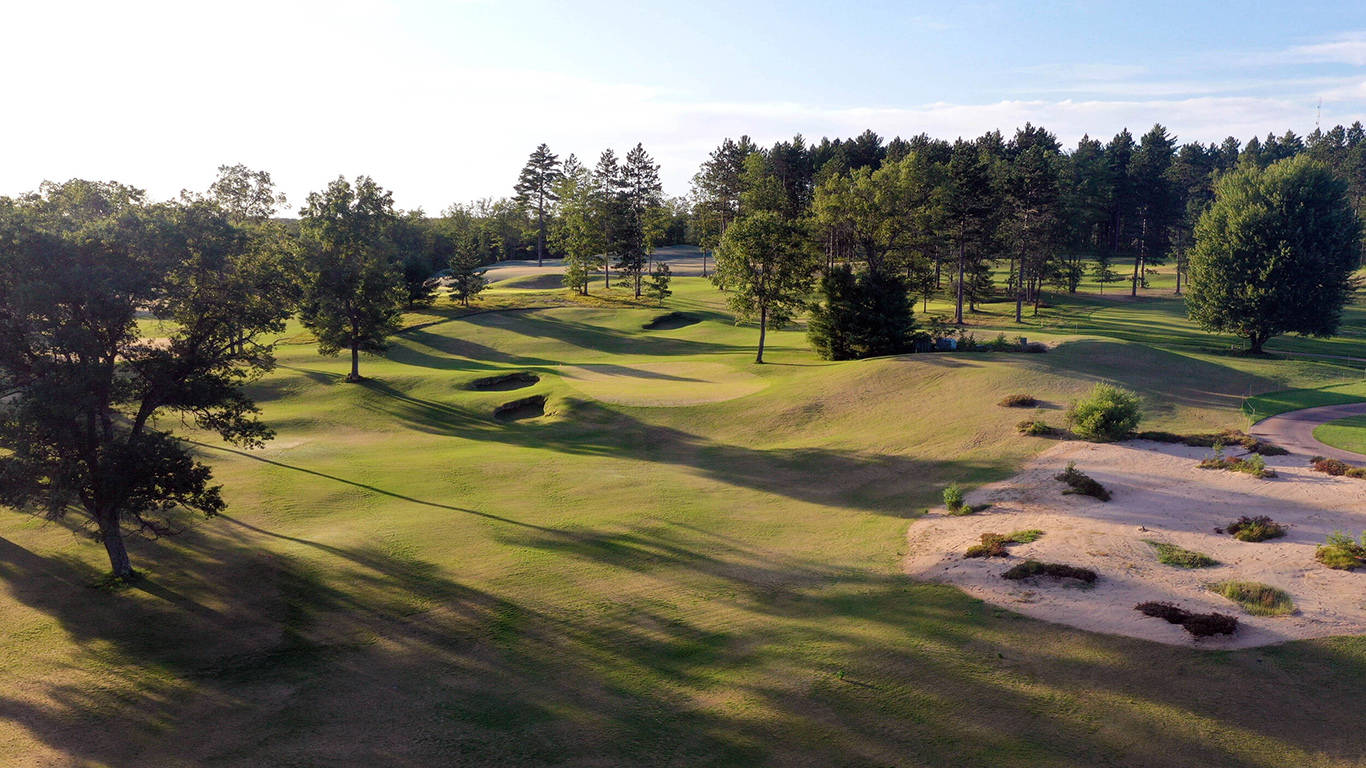
The 1st hole on the recently completed short course at Forest Dunes. Photo credit: Keith Rhebb
Closing thoughts
So tie-ins deliver pleasure through deception. They fool us into believing that the planned landscape was found, that our golfing adventure belongs to the old category of man vs. nature. We might know we’re being hoodwinked, but we’re too delighted to be offended.
That’s the idea, anyway. And it reminds me immediately of Alister MacKenzie. “The chief object of every golf architect or green-keeper worth his salt,” he says in his 1920 book Golf Architecture, “is to imitate the beauties of nature so closely as to make his work indistinguishable from nature itself.”
Further into the book, MacKenzie elaborates on his theory of nature fakery. He makes a famous analogy between building golf courses and building military earthworks. Through his service in the Second Boer War and World War I, MacKenzie became an expert in camouflage, designing fortifications that blended in with the battlefield. The parallels to his style of golf architecture were obvious. “Successful golf-course construction and successful camouflage,” he writes, “are almost entirely due to the utilization of natural features to the fullest extent and to the construction of artificial ones indistinguishable from nature.” He was, in other words, creating tie-ins.
It’s true that manmade landforms in harmony with natural ones bring us pleasure. Conversely, when the manmade clashes with the natural, we may feel uncomfortable. Since golf should be pleasurable, it stands to reason that courses should, as MacKenzie puts it, “imitate the beauties of nature.”
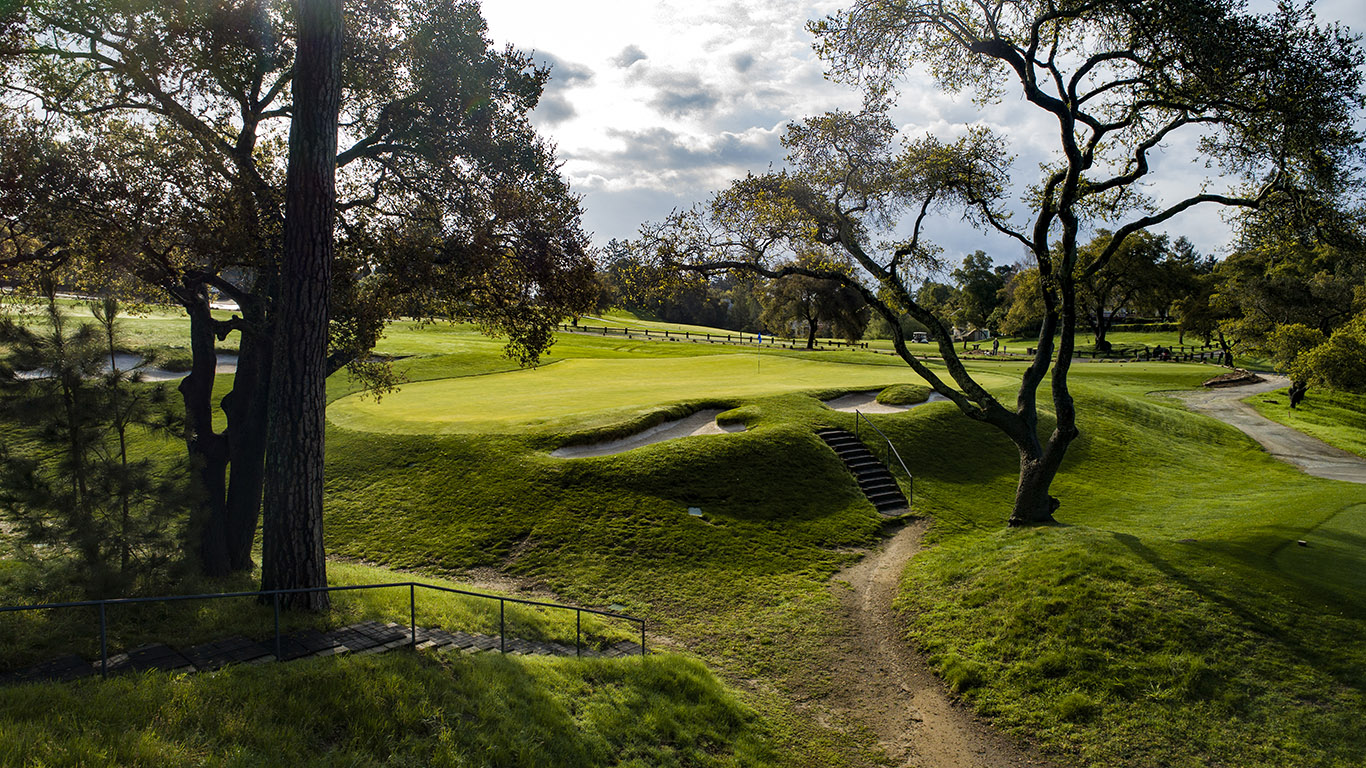
The 12th green at Alister MacKenzie's Pasatiempo. Paths, waterways, and a pushed-up green that ties in with its surrounds. Photo credit: Andy Johnson
Yet discomfort is a powerful tool for any artist. Comedians are masters of it, as are musicians. And any good storyteller knows how to unsettle us, how to give us alternating experiences of tension and release.
So why couldn’t golf architects do the same with tie-ins? At one moment, they could draw attention to the artificiality of their creations; at the next, they could provide the comforting release of camouflage.
I don’t know. Maybe this idea is more fun to babble about in a blog post than it is to put in the ground. But it’s worth considering because the future of golf course design is a big question mark right now. Bill Coore and Tom Doak are in the fourth decade of their careers, and the many talented architects they have trained, including Riley Johns, are starting to get major jobs. Where will this new generation push the craft? How will they differentiate themselves from their mentors, or from the heroes of their mentors? It’s possible that some of them will decide that imitating the beauties of nature is not, in fact, their chief object.
Got some thoughts of your own? Connect with us on Twitter @the_fried_egg, @gfordgolf (that’s me), and @IntegrativeGolf (that’s Riley). Let’s keep the discussion going.
Further exploration
Alister MacKenzie, Golf Architecture (1920)—The Spirit of St. Andrews, published six decades after MacKenzie’s death, is essentially an updated and expanded edition of his 1920 handbook. I recommend starting with the original. It can be found for free online, and it has most of the good stuff.
George Thomas, Golf Course Architecture in America (1927)—In the podcast, Riley quotes the first sentence of Thomas’s fifth chapter, “Beauty and Utility.” Another sample from the same page: “The contours of our tees, of our hazards, of our greens, of our rough, and of our fairways should, except when otherwise absolutely necessary, all melt into the land surrounding them, and should appear as having always been present.”
Adam Lawrence, “The importance of embedding golf in nature” (2017)—An excellent essay for the Golf Course Architecture magazine that surveys the current theory and practice of fitting golf courses to their sites.
Derek Duncan, “Sand Valley, Sun-N-Dale” (2019)—This course review contains an astute analysis of Coore & Crenshaw’s and David McLay Kidd’s contrasting methods of tying in their designs at the Sand Valley Resort.
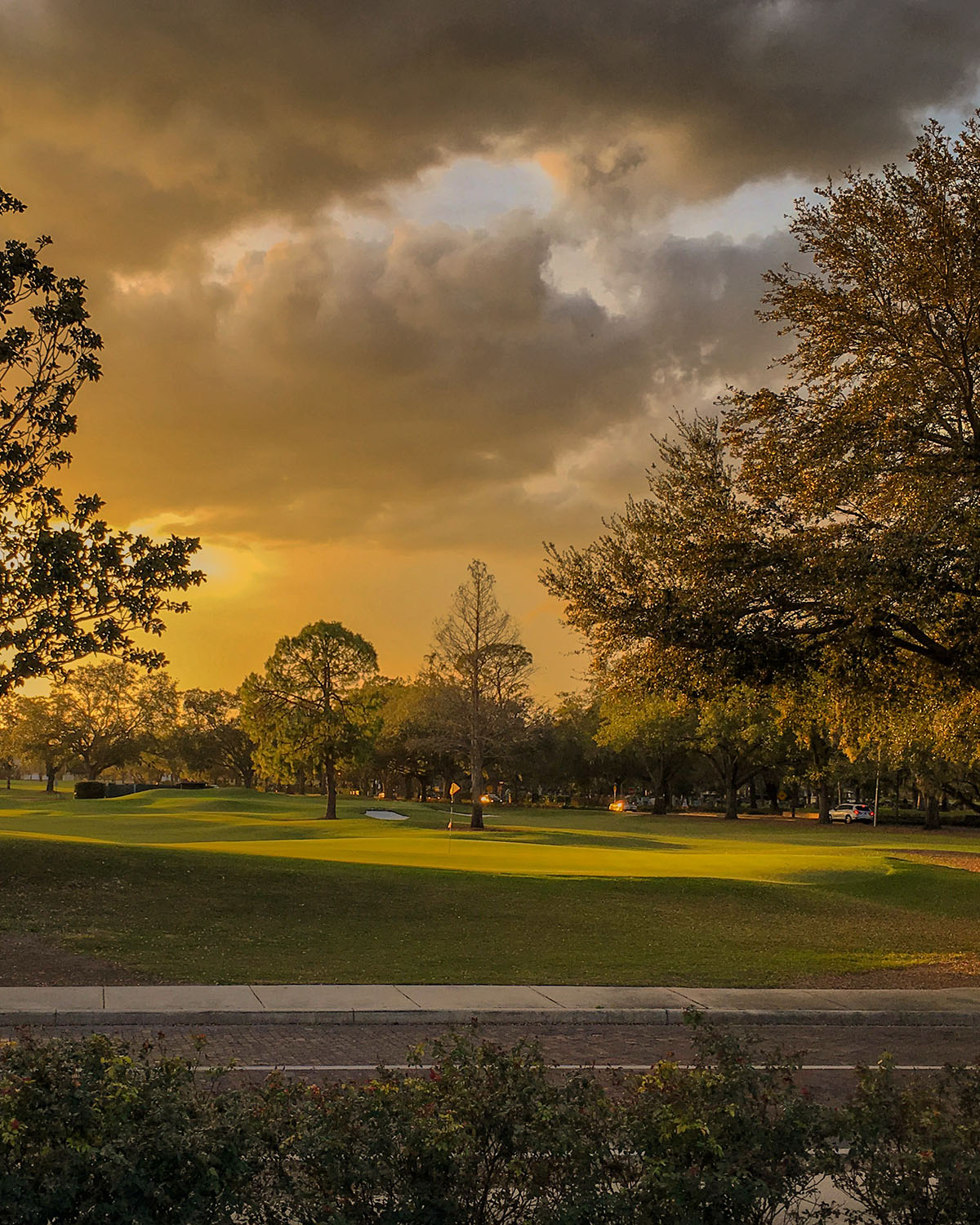
A streetscape at Winter Park. Photo credit: Riley Johns
Extras from the interview with Andy Staples
On desert golf and non-tied-in tie-ins:
Riley: Desert golf is the antithesis of [tied-in golf design]. Now you have a landscape that’s dry and arid and brown and dusty—and then you have this green, lush golf course. And usually the line is hard. It’s not often you can blend those two, just for environmental factors. One requires water, one doesn’t. But you could go to the extreme of accepting that there is no tie-in. We’re not going to even attempt a tie-in. We’re going to delineate a hard line, and that’s going to be our design element. That’s the form that we want to express. So different sites call for different modes of tying in.
Garrett: And the suitability of the site to golf probably has a lot to do with it. You have Sand Hills, which, in spite of being in a place that’s cold a lot of the year, is very well suited to golf. You put golf holes on that landscape, and they work. Whereas when you have a desert site, it’s not immediately suited to golf. And you’re saying that on a desert landscape, maybe you could make the decision not to have a tie-in, to have it clash, and to have that be the artistic statement you’re making. Is that something that you would do if you were given such a site to work with?
Riley: It would be very site specific, very environmentally driven. It’s not physical because you know that you can match the grades of your built golf course with the desert. But it’s the environmental components, the arid versus the need for water and fertilizers.
There are examples of expressing a lack of tie-in. It would be like an abrupt statement, right? And in golf typically that comes in the form of a wall. It’s a physical barrier, but it lends itself to the game of golf in a strategic way. It’s an unapologetic element that says, “This is built and there’s nothing that ties into it.” So I would lean more toward those kinds of unapologetic tie-ins—walls, structures, buildings, anything of that nature—and less toward saying, “We’re going to have a hard line here of desert to the right and green, lush grass to the left.”
But it’s so subjective, right? Golf is art. Some people love the look of desert golf where you have this green grass and blue water and brown desert. That’s totally fine. And some people love the look of a Pinehurst No. 2, where the textures and colors seem to kind of play amongst each other, and you’re not so focused on delineating where golf is played and where it’s not. It’s up to you to choose your own adventure on that landscape.


 by
by 
